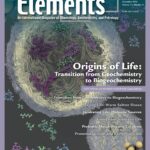
Geomicrobiology And Microbial Geochemistry, December 2015, Vol. 11, No. 6
June 28, 2024
Origins Of Life: Transition From Geochemistry To Biogeochemistry, December 2016, Vol. 12, No. 6
June 28, 2024Cosmic Dust, June 2016, Vol. 12, No. 3
$20.00
Cosmic dust is submillimeter debris shed by comets, asteroids, moons, and planets. In the Solar System, this dust scatters sunlight (the zodiacal light), and it is detected around other stars by its infrared emission.
Cosmic Dust
June 2016, Vol. 12, No. 3
Cosmic dust is submillimeter debris shed by comets, asteroids, moons, and planets. In the Solar System, this dust scatters sunlight (the zodiacal light), and it is detected around other stars by its infrared emission. Cosmic dust enters Earth’s atmosphere at high speeds and at a rate of 100 tons a day. These small particles are the largest source of extraterrestrial material accreting on the present-day Earth and include interplanetary dust particles and micrometeorites. Although atmospheric entry heating and terrestrial weathering have modified many, some particles are pristine primitive extraterrestrial materials that contain high abundances of isotopically anomalous presolar grains and primitive carbon compounds that have not been altered since their formation. Cosmic dust analysis provides invaluable information on initial planetary building materials.
Why You’ll Love Elements Magazine:
- Expert Contributors: Articles written by renowned researchers in the field of geoscience.
- Engaging Content: Join a community of readers who are passionate about Elements.
- Exceptional Quality: Each issue is printed on high-quality paper with stunning visuals and detailed illustrations that bring complex scientific concepts to life.
Order your copy of the June 2016 issue of Elements magazine today and discover cosmic dust.
Related products
-
The Nuclear Fuel Cycle – Environmental Aspects, December 2006, Vol. 2, No. 6
$20.00Increasing concerns for the effects of global warming that result from rising greenhouse gas concentrations in the atmosphere have led to a reexamination, even enthusiasm, for nuclear power. Of all the current alternatives to fossil fuels, nuclear fission is the most important source of energy, accounting for 17 percent of the world’s electricity.
-
Supervolcanoes, February 2008, Vol. 4, No. 1
$20.00Explosive super-eruptions from large volume, shallow magma systems lead to enormous and devastating pyroclastic flows, the formation of gigantic collapse calderas, and deposition of volcanic ash over continent-sized areas. Recognition that future eruptions from these “supervolcanoes” will undoubtedly have severe impacts on society—and perhaps on life itself—has led to recent public and media interest.
-
Zircon – Tiny But Timely, February 2007, Vol. 3, No. 1
$20.00Where would Earth science be without zircon? As Earth’s timekeeper, zircon has proven to be a remarkable and versatile mineral, providing insights into deep time and ancient Earth processes. However, there is still much to learn about Earth’s history from zircon and its behaviour.




